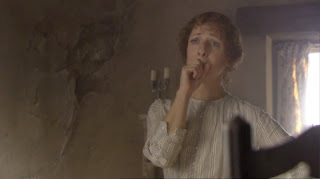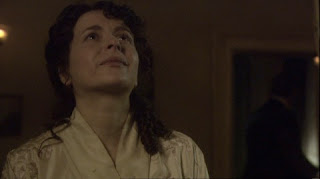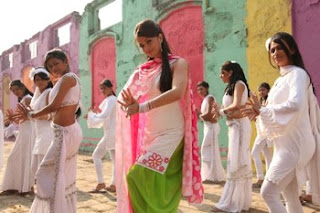Men against women: 7 Khoon Maaf, No One Killed Jessica, and Pardes
 7 Khoon Maaf (Seven Forgiven Murders, 2011) is Vishal Bhardwaj's attempt at a modern film noir. According to a typology proposed by John Blaser in No Place for a Woman: The Family in Film Noir, there are three kinds of noir women: the supportive Good Woman, the suffocating Marrying Kind, and the seductive Femme Fatale. Typically, the femme fatale "refuses to play the role of devoted wife and loving mother that mainstream society prescribes for women."
7 Khoon Maaf (Seven Forgiven Murders, 2011) is Vishal Bhardwaj's attempt at a modern film noir. According to a typology proposed by John Blaser in No Place for a Woman: The Family in Film Noir, there are three kinds of noir women: the supportive Good Woman, the suffocating Marrying Kind, and the seductive Femme Fatale. Typically, the femme fatale "refuses to play the role of devoted wife and loving mother that mainstream society prescribes for women."
But in 7 Khoon Maaf, being a devoted wife and loving mother is all that Susanna (Priyanka Chopra) wants. Unfortunately for her and for them, the men who are drawn to marry her all have fatal flaws: they are emotionally repressed and controlling (the wooden Neil Nitin Mukesh is perfectly cast in the role of a rigid army officer), needy and narcissistic (John Abraham as a heroin- and groupie-addicted rock star), brutal (Irrfan Khan as a sadistic poet), deceptive (Aleksandr Dyachenko as a Russian agent with a double life), exploitative (Annu Kapoor as a police inspector who coerces Susanna into sex), and murderous (Naseeruddin Shah as a doctor whose mushroom diet can cure or kill). Those flaws are literally fatal for each of the men in turn, for like Blaser's description of the classic femme fatale, Susanna must "resort to murder to free herself from an unbearable relationship with a man who would try to possess and control her, as if she were a piece of property or a pet."
I haven't read the Ruskin Bond short story "Susanna's Seven Husbands" on which writer/director Bhardwaj based his movie, but the main problem with the film version is one of tone. At times 7 Khoon Maaf seems to be straining for black comedy, and at others seems to take itself entirely seriously. There's also a distracting issue with chronology—characters seem to age at different rates—and an unmotivated ending. Although it's interesting to see Priyanka playing such an ambiguous role, it's not the best work of anyone involved.
 No One Killed Jessica (2011) highlights a real-life incident in which, in front of horrified witnesses at a party, model Jessica Lall was shot and killed by Manu Sharma, the son of a high-ranking politician. When the case finally came to trial after seven years, a taped confession by the killer was ruled inadmissible, it was discovered that evidence had been tampered with, and several key eyewitnesses retracted their testimony and claimed that they hadn't seen the shooting after all. Sharma and his accomplices were acquitted.
No One Killed Jessica (2011) highlights a real-life incident in which, in front of horrified witnesses at a party, model Jessica Lall was shot and killed by Manu Sharma, the son of a high-ranking politician. When the case finally came to trial after seven years, a taped confession by the killer was ruled inadmissible, it was discovered that evidence had been tampered with, and several key eyewitnesses retracted their testimony and claimed that they hadn't seen the shooting after all. Sharma and his accomplices were acquitted.
Two reporters from the newsmagazine Tehelka, Harinder Baweja and Vineet Khare, went undercover to investigate witness tampering and police malfeasance in the case. Through dogged and courageous work the journalists exposed the bribes and intimidation employed by the Sharma family to turn the witnesses and contaminate the evidence.
It's a compelling story, well-presented by writer/director Raj Kumar Gupta. And it's a true pleasure to watch the interplay between Vidya Balan as Jessica's sister Sabrina and Rani Mukherji as fictionalized crusading journalist Meera Gaity. Meera isn't a cardboard heroine: she smokes, is far from demure, sleeps with her sometime boyfriend, and won't take no for an answer. It's great to see Rani—who sometimes seems to be cast for her ability to twinkle appealingly and cry convincingly—in the role of a tough, feisty and not entirely likeable woman. In the role of Sabrina, Vidya Balan convincingly portrays a woman slowly emerging from emotional shell-shock and beginning to acknowledge the possibility of hope. Note to Bollywood producers: can we please have more movies with substantive, complex roles for actresses of the caliber of Rani and Vidya?
 In Pardes (Foreign, 1997), Ganga (Mahima Chaudhry in her film debut) is a beautiful, voluptuous but innocent girl brought up in an idyllic rural village. As her name and other attributes might suggest, Ganga is the embodiment of Traditional Indian Values. Which is precisely why NRI millionaire Kishorilal (Amrish Puri) approaches Ganga's father Suraj Dev (Alok Nath) to arrange Ganga's marriage to his son.
In Pardes (Foreign, 1997), Ganga (Mahima Chaudhry in her film debut) is a beautiful, voluptuous but innocent girl brought up in an idyllic rural village. As her name and other attributes might suggest, Ganga is the embodiment of Traditional Indian Values. Which is precisely why NRI millionaire Kishorilal (Amrish Puri) approaches Ganga's father Suraj Dev (Alok Nath) to arrange Ganga's marriage to his son.
In a Yash-Chopra-esque song sequence for "I Love My India," Kishorilal, Ganga, Suraj Dev—and director Subhash Ghai in a brief cameo—celebrate the folkloric, mythical, unchanging India that for the men is represented by Ganga:
Yeh duniya ik dulhan
Dulhan ke maathe ki bindiya
Yeh mera India
I love my India
Vatan mera India
Sajan mera India
Karam mera India
Dharam mera India
The world is a bride,
and the jewel on her forehead
is my India.
I love my India.
India my homeland,
India my beloved,
India my fate,
India my religion:
Kishorilal's son Rajiv (Apurva Agnihotri) is thoroughly Westernized, meaning that he smokes, drinks, and sleeps with his (ex-?)girlfriend. Rajiv's foster brother Arjun (Shah Rukh Khan) is sent to India to act as a go-between. As Arjun's name suggests, he's loyal to a fault: he claims that a pack of cigarettes that Ganga finds in Rajiv's coat is his own, and when she pleads for the truth tells her that Rajiv will make her happy.
Of course, when Ganga travels to America to visit with Rajiv after their engagement, things don't go well. On a visit to Las Vegas, the city that epitomizes Western sinfulness, a drunken Rajiv tries to rape Ganga. Arjun promises to help Ganga and returns with her to India, immediately leading Rajiv, Kishorilal, and Suraj Dev to conclude that they are having an affair. Soon all three are trying to kill Arjun.
Perhaps the Subhash Ghai writing and directing credits should have given me fair warning me about Pardes. For me, Ghai's movies require having a finger ever ready to press the fast forward button on the DVD remote; see my brief review of Khal Nayak (The Anti-Hero, 1993), and Ajnabi's hilarious essay on the "shameful classic" Yaadein (Memories, 2001). When Alok Nath, Bollywood's quintessential Good Dad, is reduced to a screaming maniac wielding a sword and trying to kill his own daughter and her supposed lover, then we're too deep into Subhash Ghai Land for the likes of me.
If you can ignore the movie's simplistic dichotomies and a story that's both unoriginal and over-the-top, Pardes does have some redeeming features. The lovely Chaudhry is styled and dressed to look like Madhuri Dixit circa Khal Nayak, which is not a bad thing. And as the catchy "I love my India" suggests, the music is well done, especially the climactic qawwali "Nahin Hona Tha". Finally, as huge SRK fans my partner and I are willing to forgive much in order to watch our man in action. But I don't think we'll ever be tempted again to go Pardes.























